Related Research Articles

Bosko is an animated cartoon character created by animators Hugh Harman and Rudolf Ising. Bosko was the first recurring character in Leon Schlesinger's cartoon series and was the star of thirty-nine Looney Tunes shorts released by Warner Bros. He was voiced by Carman Maxwell, Johnny Murray, and Billie "Buckwheat" Thomas during the 1920s and 1930s and once by Don Messick during the 1990s.

Isadore "Friz" Freleng, credited as I. Freleng early in his career, was an American animator, cartoonist, director, producer, and composer known for his work at Warner Bros. Cartoons on the Looney Tunes and Merrie Melodies series of cartoons from the 1930s to the early 1960s. In total he created more than 300 cartoons.

Hugh Harman was an American animator. He was known for creating the Warner Bros. Cartoons and MGM Cartoons studios and his collaboration with Rudolf Ising during the Golden Age of American animation.
Hugh Harman and Rudolf Ising were an American animation team and company known for founding the Warner Bros. and Metro-Goldwyn-Mayer animation studios. In 1929, the studio was founded under the name Harman-Ising Productions, producing Looney Tunes and Merrie Melodies for Leon Schlesinger from 1930 to 1933. From 1934 to 1938, Harman-Ising produced the Happy Harmonies series, with William Hanna as their employee.

Buddy is an animated cartoon character in the Looney Tunes series by Leon Schlesinger Productions. He was the second star of the series, after Bosko.
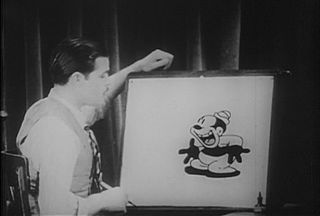
Rudolf Carl "Rudy" Ising was an American animator best known for collaborating with Hugh Harman to establish the Warner Bros. and MGM Cartoon studios during the early years of the golden age of American animation. In 1940, Ising produced William Hanna and Joseph Barbera's first cartoon, Puss Gets the Boot, a cartoon featuring characters later known as Tom and Jerry.

Bosko the Doughboy is a one-reel 1931 short subject animated cartoon, part of the Bosko series. It was directed by Hugh Harman, and first released on October 17, 1931 as part of the Looney Tunes series from Harman-Ising Productions and distributed by Warner Bros.

Piggy is the name of two animated cartoon characters in the Merrie Melodies series of films distributed by Warner Bros. The first character was a fat, black pig wearing a pair of shorts with two large buttons in the front, and his first film was You Don't Know What You're Doin'!

Foxy is an animated cartoon character featured in the first three animated shorts in the Merrie Melodies series, all distributed by Warner Bros. in 1931. He was the creation of animator Rudolf Ising, who had worked for Walt Disney in the 1920s.
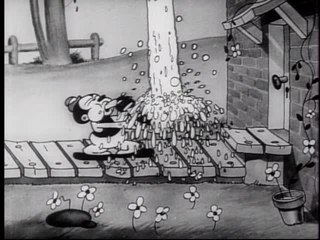
Sinkin' in the Bathtub is the first Warner Bros. theatrical cartoon short as well as the first of the Looney Tunes series. The short debuted in April 1930, at the Warner Bros. Theater in Hollywood. The cartoon features Bosko, and the title is a pun on the 1929 song Singin' in the Bathtub. The film was erroneously copyrighted under the same title as the 1929 song. It is now in the public domain in the United States as the copyright was not renewed.
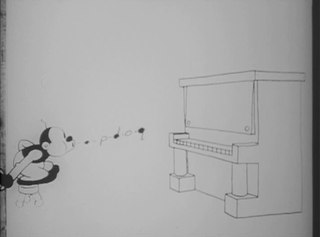
Bosko, the Talk-Ink Kid is a 1929 live-action/animated short film produced to sell a series of Bosko cartoons. The film was never released to theaters, and therefore not seen by a wide audience until 2000 on Cartoon Network's television special Toonheads: The Lost Cartoons. The film was produced on May 29, 1929 and directed by Hugh Harman and Rudolf Ising.
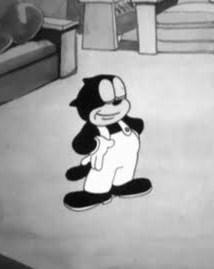
Beans the Cat is an animated cartoon character in the Warner Bros. Cartoons series of cartoons from 1935–1936. Beans was the third Warner Bros cartoon character star after Bosko and Buddy. He was voiced by Billy Bletcher. He was created by director Friz Freleng. The character was featured in nine cartoons made in 1935 and 1936.
Bosko's Picture Show is a Warner Bros. Looney Tunes animated short directed by Hugh Harman and Friz Freleng. It was the last Looney Tunes Bosko cartoon produced by Hugh Harman and Rudolf Ising for Leon Schlesinger and Warner Bros. The duo moved on to produce cartoons for MGM, the first of which were released in 1934. The music score was a work of Frank Marsales.

The Booze Hangs High, released in December 1930, is the fourth title in the Looney Tunes series. The short features Bosko, Warner Bros.' first cartoon character.
This is a listing of all the animated shorts released by Warner Bros. under the Looney Tunes and Merrie Melodies banners between 1930 and 1939, plus the pilot film from 1929 which was used to sell the Looney Tunes series to Leon Schlesinger and Warner Bros. A total of 270 shorts were released during the 1930s.
Ride Him, Bosko! released in 1932, is a Western animated short film in Warner Bros.' Looney Tunes series. It features Bosko, Warner Bros.' first cartoon character and his sweetheart Honey in the Old West.
Bosko's Parlor Pranks is a 1934 Happy Harmonies cartoon produced by Hugh Harman and Rudolph Ising for Metro-Goldwyn-Mayer starring their character Bosko. It is the first Bosko cartoon produced in color, and the first made at MGM following the Harman-Ising studio ending its deal to produce Looney Tunes and Merrie Melodies for Warner Bros. and Leon Schlesinger. Warner Bros. would later own Happy Harmonies and the MGM cartoon studio through its Turner Entertainment Co. banner.
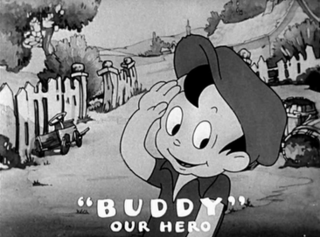
Buddy's Day Out is a 1933 Warner Bros. Looney Tunes cartoon, directed by Tom Palmer. The short was released in theaters on September 9, 1933, premiering with Goodbye Again, and was the first cartoon to feature Buddy, the second star of the series who was created by Earl Duvall.
Yodeling Yokels is a 1931 one-reel short subject featuring Bosko; it is part of the Looney Tunes series. It was released in June 1931 and is directed by Hugh Harman and Rudolf Ising. The film score was composed by Frank Marsales.

The Tree's Knees is a 1931 one-reel short subject featuring Bosko, part of the Looney Tunes series. It was released in August 1931 and is directed by Hugh Harman and Rudolf Ising, the last cartoon in the series to be directed by the two. Every Looney Tunes cartoon after this was directed by Hugh Harman until 1933, and every Merrie Melodies cartoon was directed by Rudolf Ising until the aforementioned year. It is also the last Bosko cartoon to not feature the main character's (Bosko's) name in the title. The short is also notable for the extensive use of footage from the earlier short Ain't Nature Grand! that it reuses, in particular a scene of Bosko happily and innocently pursuing a butterfly.
References
- ↑ Beck, Jerry; Friedwald, Will (1989). Looney Tunes and Merrie Melodies: A Complete Illustrated Guide to the Warner Bros. Cartoons. Henry Holt and Co. p. 1. ISBN 0-8050-0894-2.
- ↑ Lenburg, Jeff (1999). The Encyclopedia of Animated Cartoons. Checkmark Books. pp. 57–58. ISBN 0-8160-3831-7 . Retrieved June 6, 2020.
- ↑ "Hold Anything". IMDb .